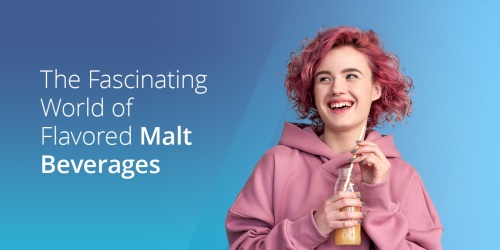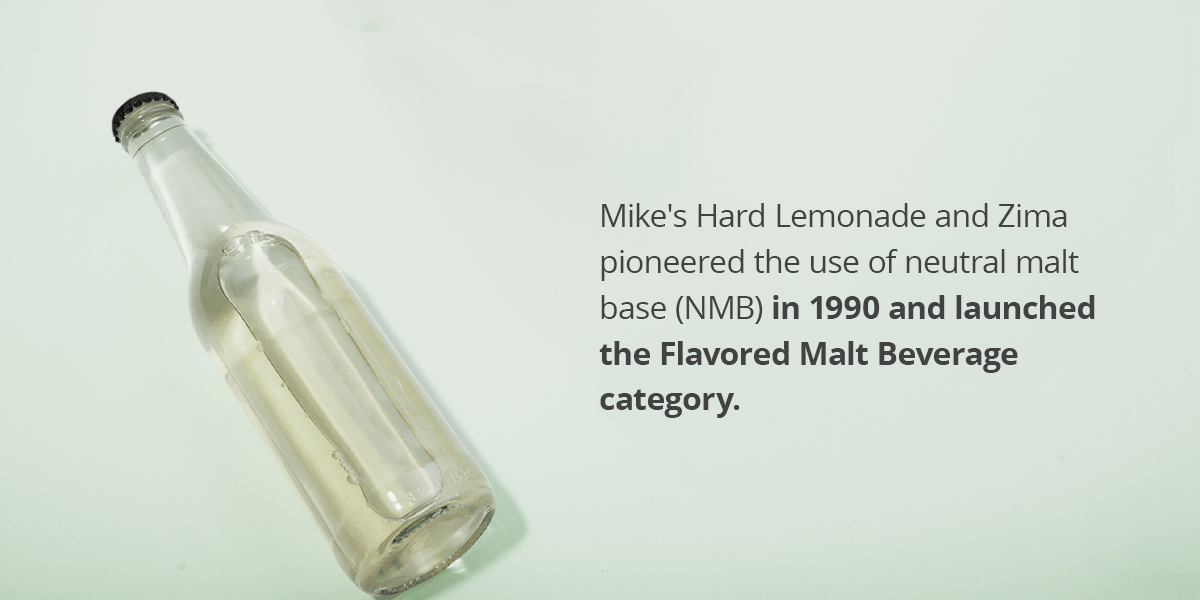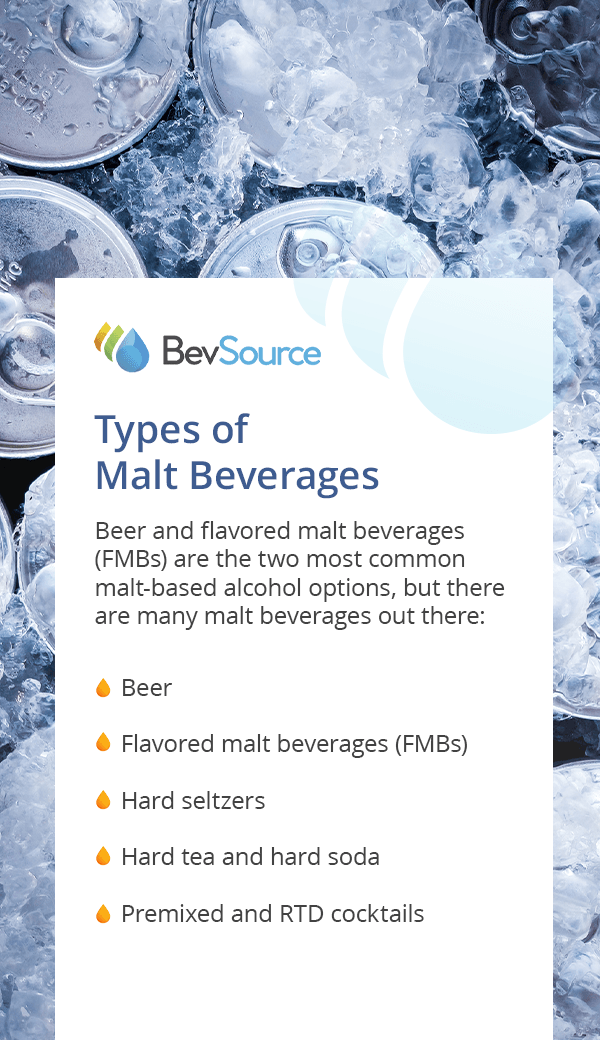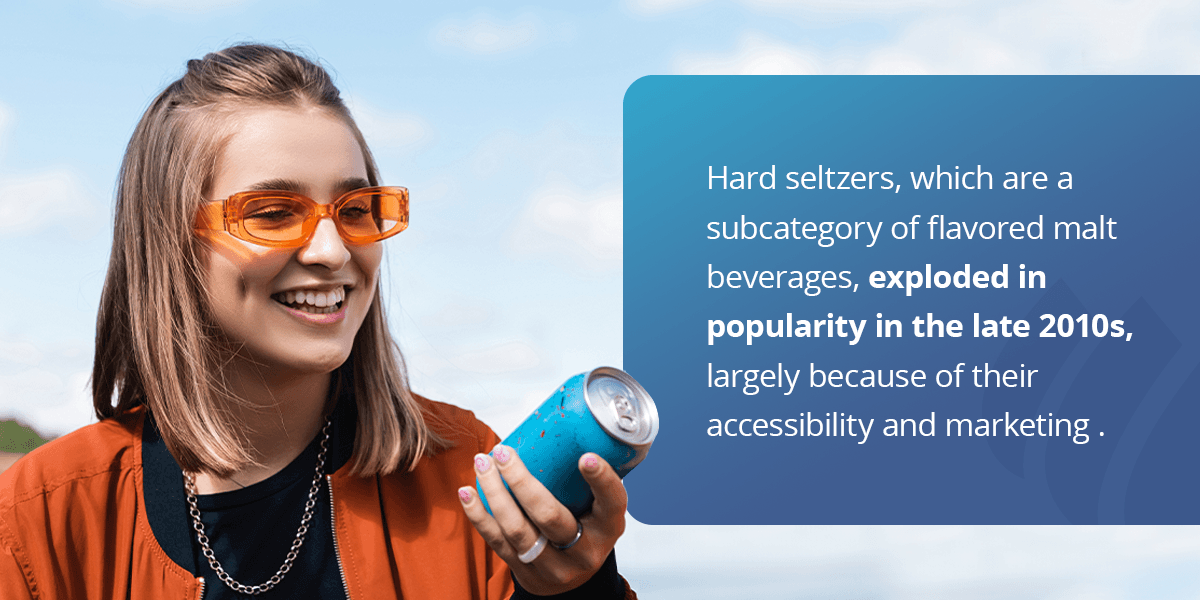The Fascinating World of Flavored Malt Beverages

The name "flavored malt beverage" may not sound particularly interesting, but the FMB category has played a fascinating and fast-changing role in the current and future beverage market. Over the course of 2023, Circana data shows United States FMB sales reached almost $4.4 billion — a 16.1% increase from the year prior. Case sales had also increased by 12.7%
Since the 1990s, flavored malt beverages have popped up in multiple forms. Mike's Hard Lemonade and Zima pioneered the use of neutral malt base (NMB) in 1990 and launched the Flavored Malt Beverage category. These FMBs offered a sweeter, more approachable alternative to beer and spirits.
The category has since evolved with a wider variety of flavors and styles. Today, FMBs remain a relevant beverage category with a loyal following. They cater to a diverse range of consumers seeking variety and flavor options within the realm of malt beverages.
While flavor is a significant contributing factor to their popularity, FMB brands need to embrace other opportunities. The future of FMBs likely lies in continued innovation, with brands catering to evolving consumer preferences for healthier ingredients, convenience and unique flavor combinations to stay relevant. Explore what makes a malt beverage and what the future holds in store for the FMB market.

Types of Malt Beverages
Alcoholic malt beverages are produced through the alcoholic fermentation of barley, malt, hops or similar ingredients in water. This results in a beverage with an alcohol content greater than 3.2% by weight. The United States Federal Alcohol Administration Act (FAA) states that malt alcoholic beverages must be made from a 25% malt base and contain a minimum of 7.5 pounds of hops per hundred barrels of finished product.

Beer and flavored malt beverages (FMBs) are the two most common malt-based alcohol options, but there are many malt beverages out there:
- Beer: Once scientists discovered yeast as a fermenting organism, beer production could take off. Beer is typically made from malted cereal grains, hops and water fermented by yeast.
- Flavored malt beverages (FMBs): Flavored malt beverages include natural or artificial flavors that give the beverages a distinct taste profile. Popular FMBs — or "malternatives" — include Mike's Hard Lemonade, Smirnoff Ice and ready-to-drink (RTD) cocktails like Cayman Jack Margaritas.
- Hard seltzers: Three years after the launch of White Claw and Truly in 2016, hard seltzers became the fastest-growing segment in the beer category. Although most hard seltzers are made from fermented cane sugar ("sugar brew"), including White Claw and Truly, many are also made from a malt base. Regardless of their alcohol base, both sugar brew and malt-based seltzers fall under the "beer" category, with some syndicated data providers tracking hard seltzers as a segment of the FMB market and others tracking them separately.
- Hard tea and hard soda: Hard teas, such as Twisted Tea and Monster's Nasty Beast Hard Tea, and hard sodas, such as Hard Mtn Dew, offer alternatives to traditional FMBs like Mike's Hard Lemonade and Smirnoff Ice.
- Premixed and RTD cocktails: Like hard teas, sodas and seltzers, malt-based ready-to-drink cocktails, such as Cayman Jack Margaritas and Clubtails Cocktails, are also worth noting. Restrictive regulations limiting where spirit-based RTD cocktails can be sold, as well as their premium price, means malt-based cocktails continue to remain popular with consumers.
Confusingly, hard kombuchas, similar to hard seltzers, are reported by syndicated data providers as an FMB. Yet, these beverages are fermented teas, not malt-based drinks.
Malt Beverage vs. Beer: What's the Difference?
You've likely seen "beer" and "malt beverages" used interchangeably, and there's good reason for that. There's barely a difference between the two.
Fermented malt liquor, commonly known as "malt liquors," refers to a beverage produced through the alcoholic fermentation of a combination of barley, malt, hops or similar ingredients in water. This results in a beverage with an alcohol content greater than 3.2% by weight. Under the Federal Alcohol Administration Act, in the U.S., a malt beverage must be made from a base that is 25% malt and must contain at least 7.5 pounds of hops per 100 barrels of finished product. Beer and FMB are the two most common malt beverages.
Beer consists of hops, malted cereal grains (often barley, but sometimes a different grain) and water fermented by adding yeast. So, most beers are malt beverages, with a few exceptions — some beers are fermented from an ingredient other than barley malt. For example, gluten-free beers are often made using sorghum malt instead of barley malt. Most malt beverages are taxable beers, except for beers with alcohol content less than 0.5% alcohol by volume (ABV).
The term malt beverage also applies to drinks made using malt base with natural or artificial flavors added to create a taste profile that differs from traditional beer. Neutral malt base (NMB) is a popular malt base for flavored malt beverages or hard seltzers because of its neutral taste profile. NMB is an alcoholic base derived from malt that has been stripped of all its malt characteristics, such as color and odor. Under Alcohol and Tobacco Tax and Trade Bureau (TTB) regulations, both malt- and sugar-based hard seltzers are considered "beer," but only malt-based hard seltzers are also considered "malt beverages."
To remain in the malt beverage category for tax purposes, FMBs must still be made with a legal malt base, and at least 51% of the final alcohol in the product must be derived from that malt base. If a beer or malt beverage contains more than 6% ABV, not more than 1.5% of the volume of the finished product may consist of alcohol derived from flavorings and other non-beverage ingredients.
Why Classifications Matter
Meeting the qualifications for a flavored malt beverage can have huge implications on a product from a labeling, marketing, distribution and tax perspective. An FMB may fall under Alcohol and Tobacco Tax and Trade Bureau (TTB) regulation, Food and Drug Administration (FDA) regulation or both. The FDA-regulated labeling requirements apply to any beer made with ingredients other than barley and hops. TTB requirements govern malt-based products, distilled spirit-based products and wines with over 7% ABV. These products will need a Certificate of Label Approval (COLA) and, most likely, formula approval. FDA-regulated products must include nutrition facts and other information the TTB doesn't require. Some products that fall under the FDA's labeling jurisdiction will still need TTB formula approval.
To remain in the malt beverage category for tax purposes, producers must make FMBs with a legal malt base, deriving at least 51% of the final alcohol in the product from that base. If a beer or malt beverage has an ABV exceeding 6%, no more than 1.5% of the final product's volume can consist of alcohol derived from flavorings and other non-beverage ingredients.
Creativity and Confusion
Between the latest brewing methods, formulations and the creative minds of marketers, the lines between segments and categories are blurring. Some FMB brand owners choose to market their beverage as a flavored beer or a drink brewed like a beer, blurring the lines between traditional beer and FMBs for consumers. And often, any type of seltzer or hard soda is categorized as an FMB, even when it uses a fermented sugar base and not a malt-derived base.
You only have to look at the controversy over a product like Small Town Brewery's "Not Your Father's Root Beer" to see how the conversation can get confusing, even for those familiar with the rules and regulations. This product claims to be a craft beer, but many would categorize it as an FMB. Innovation inevitably brings some confusion, but in the meantime, you can aim to market your product as accurately as possible amid the blurring lines between segments and categories.
The Future of FMBs

Confusing or not, consumers seem to be embracing FMB innovation, and companies consider it an opportunity to entice more customers and build their brands. Large and small brewers have developed FMBs to appeal to drinkers who would typically choose other flavors over beer. For example, spirit brands have enjoyed the tax advantage of classification as malt-based beverages vs. distilled spirits, and they can expand brand awareness and familiarity by providing FMBs under their original spirit brand. Hard seltzers, which are a subcategory of flavored malt beverages, exploded in popularity in the late 2010s, largely because of their accessibility and marketing as Better For You products. The hard seltzer industry has already reached an at-home revenue of $11.4 billion in 2024 alone.
The future is exciting, and we've only scratched the surface of what could happen next. There is ample room for growth in the FMP market, from premium refreshers to increased BFY options.
Develop Your Own Beverage With BevSource!
Malt beverages offer a thrilling opportunity for beverage brands to make their mark in a new market or expand their reach. With BevSource, you can harness the power of creativity and expertise to optimize your beverage brand and make it truly stand out. With our extensive network of vendors and suppliers, we can help you source, develop and produce your beverage products, taking your brand from formulation to commercialization and beyond. Wherever you are in your beverage journey, we eagerly support those who embrace innovation and creativity.
If you're hoping to expand into the FMB market — or to build your FMB brand from conception — turn to BevSource. Leverage 20 years of beverage development and operations experience. Contact us to get started and speak with a beverage expert today!

Disclaimer: The information in this article is intended to convey general information regarding beverage laws, taxes and compliance and it does not constitute legal advice. This is for informational purposes only, and we strongly encourage you to seek independent legal counsel for advice on specific legal issues.

